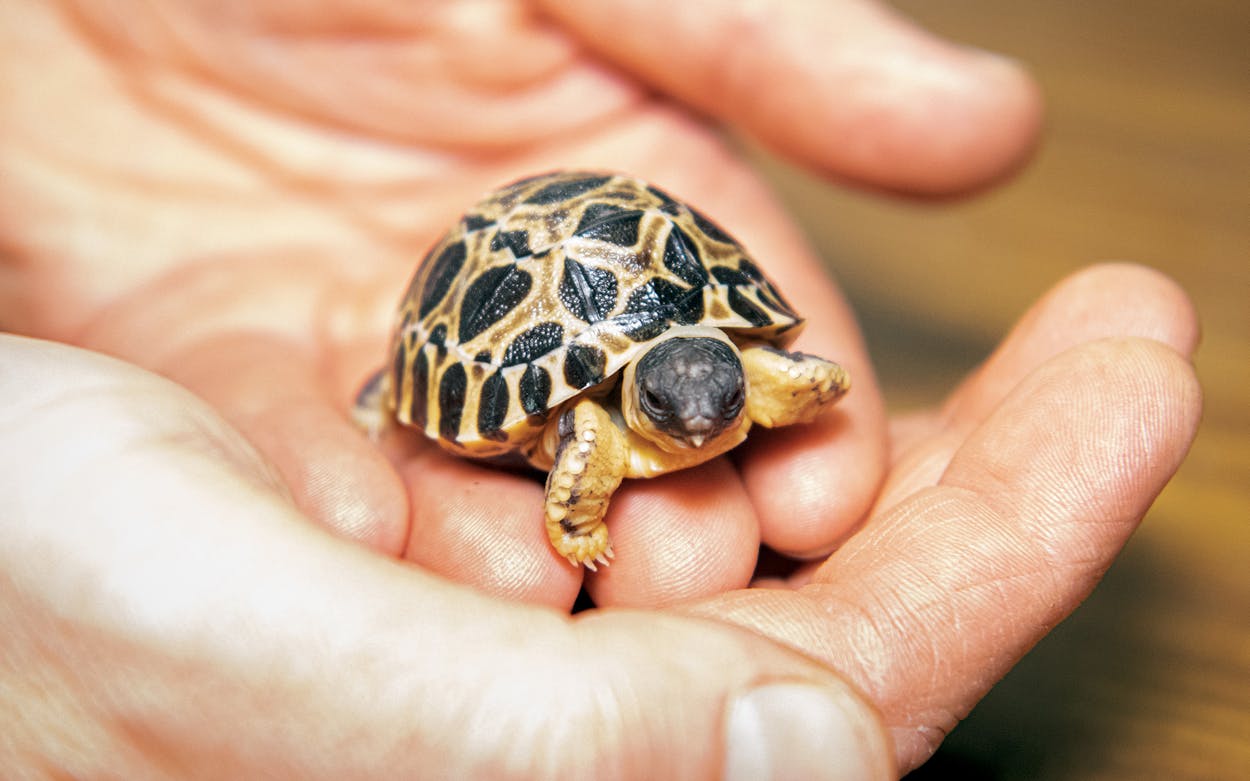WHO: Mr. and Mrs. Pickles, two radiated tortoises at the Houston Zoo.
WHAT: They are the proud parents of three new hatchlings: Dill, Gherkin, and Jalepeño Pickles.
WHY IT’S SO GREAT: Well, first of all, tiny babies are always great, especially when they have itsy-bitsy tortoise shells and wee little beaks, with teeny feet that are all pigeon-toed and whatnot. But these bundles of joy are even more miraculous, as the radiated tortoise, native to the forests and scrublands of Madagascar, is a critically endangered species. And Mr. and Mrs. Pickles are in many ways the Abraham and Sarah of the tortoise world, becoming parents at 90 and 53 years of age.
The Pickleses first met in 1996, when Mrs. Pickles (née unknown) arrived at the Houston Zoo. Originally from the Malagasy Republic, Mrs. Pickles arrived at the Dallas Zoo in 1970, not long after her first birthday, before moving to zoos in Brownsville, then San Antonio, then Houston, placing her comfortably in the category of “wasn’t born in Texas but got here as soon as I could.” The then-27-year-old was instantly drawn to Mr. Pickles, 37 years her senior, who likely regaled her with tales of his adventures traveling through Europe during his teens and twenties, which was in the 1950s, because that’s how old he is. Hatched in the wild in Madagascar in 1932, Pickles has spent his golden years in Space City, having retired to the Houston Zoo in 1987. Nine years later he met the love of his life, and though there was a slight hiccup in 1997 when Mrs. Pickles laid an egg that had been accidentally fertilized by another man, Mr. Pickles became a stepfather to her son, Fluke (who still lives at the Houston Zoo), and the Pickleses’ May-December romance has stood the test of time.
Few expected Mr. Pickles to live as long as he has. Years ago, experts in the field began creating a plan to restore the radiated tortoise’s endangered population. The plan included a numbered list of breedable males that is referred to as the “studbook,” and because Mr. Pickles is so old, he is, quite literally, the world’s “number one stud.”
The miracle Pickles triplets would not be around had a member of the zoo’s herpetology team not happened to see Mrs. Pickles in the act of laying and burying her eggs. Radiated tortoise eggs do not thrive in Houston’s climate. “Our soil is really not conducive to the growth of radiated tortoise eggs,” says the zoo’s herpetology and entomology curator Stan Mays. “It packs down, it holds a lot of water, so unless you’re lucky to see the eggs as they’re being laid, they typically won’t develop.”
For five months, zoo employees monitored the eggs closely, chilling them to around fifty degrees Fahrenheit and later placing them in an incubator set in the eighties to mimic what would happen in their natural habitat. It worked, and last week the zoo announced the arrival of the Pickleses’ new bundles of joy. The good news was very welcome for the Texas zoo community, which has suffered a spate of bad luck over the last few months. The Dallas Zoo was the target of a series of bizarre crimes earlier this year (stolen monkeys and an escaped leopard were recovered, thank goodness), and seven people were injured when a massive cedar elm branch broke off at the San Antonio Zoo last week.
This is great zoo news not just for Texas but for the world. The radiated tortoise is currently listed as endangered, but experts fear the tortoise could become extinct in the next couple decades. They rarely produce offspring, and they can command a high price on the black market for the distinct yellow starlike pattern on their domed shells. The Pickles triplets will be safe, however, and remain in the care of the herpetology team until they are big enough to join their parents. They may live as long as 150 years and weigh as much as 35 pounds. Mom and Dad will surely have their adorable hands full.
- More About:
- Critters
- Best Thing in Texas
- Houston








